BSc Architectural Design & Technology: Procurement & Design Report
VerifiedAdded on 2022/12/03
|14
|3092
|171
Report
AI Summary
This report, prepared for a BSc Architectural Design & Technology course, delves into the core aspects of design procedures and procurement within the construction industry. It examines stakeholder identification, their roles, and the various types of appointments and contracts they utilize. The report explores different architectural practices, human and physical resources, and the purpose of the RIBA plan of work. It analyzes various procurement paths, their advantages, and disadvantages, along with bill of quantities costing and tendering processes. Furthermore, the report details different building contracts, factors leading to contract termination, and the roles and responsibilities of main contractors in project management and contract administration. The document provides a comprehensive overview of the critical elements involved in successfully managing construction projects, offering valuable insights into the practical and theoretical aspects of design and procurement.
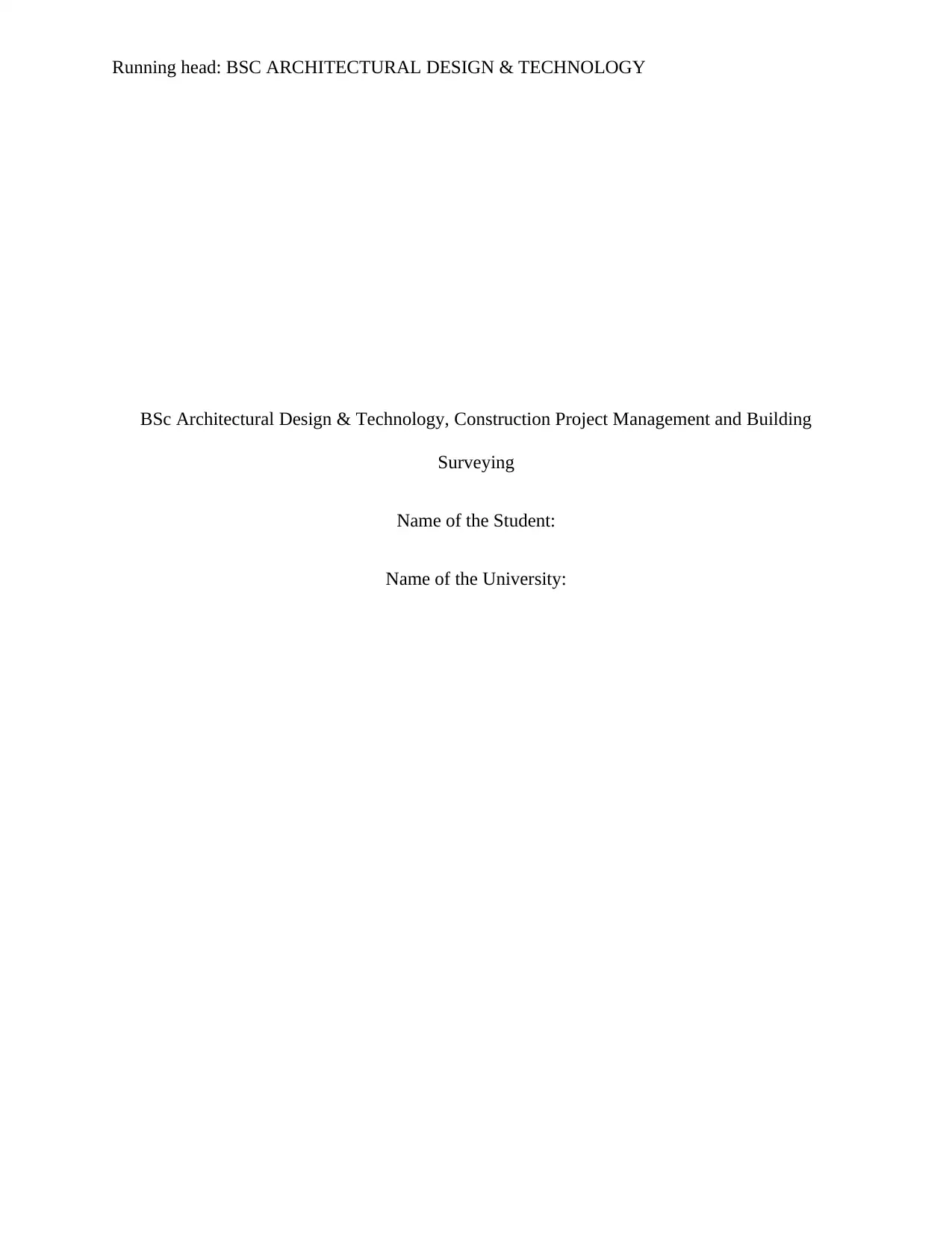
Running head: BSC ARCHITECTURAL DESIGN & TECHNOLOGY
BSc Architectural Design & Technology, Construction Project Management and Building
Surveying
Name of the Student:
Name of the University:
BSc Architectural Design & Technology, Construction Project Management and Building
Surveying
Name of the Student:
Name of the University:
Paraphrase This Document
Need a fresh take? Get an instant paraphrase of this document with our AI Paraphraser
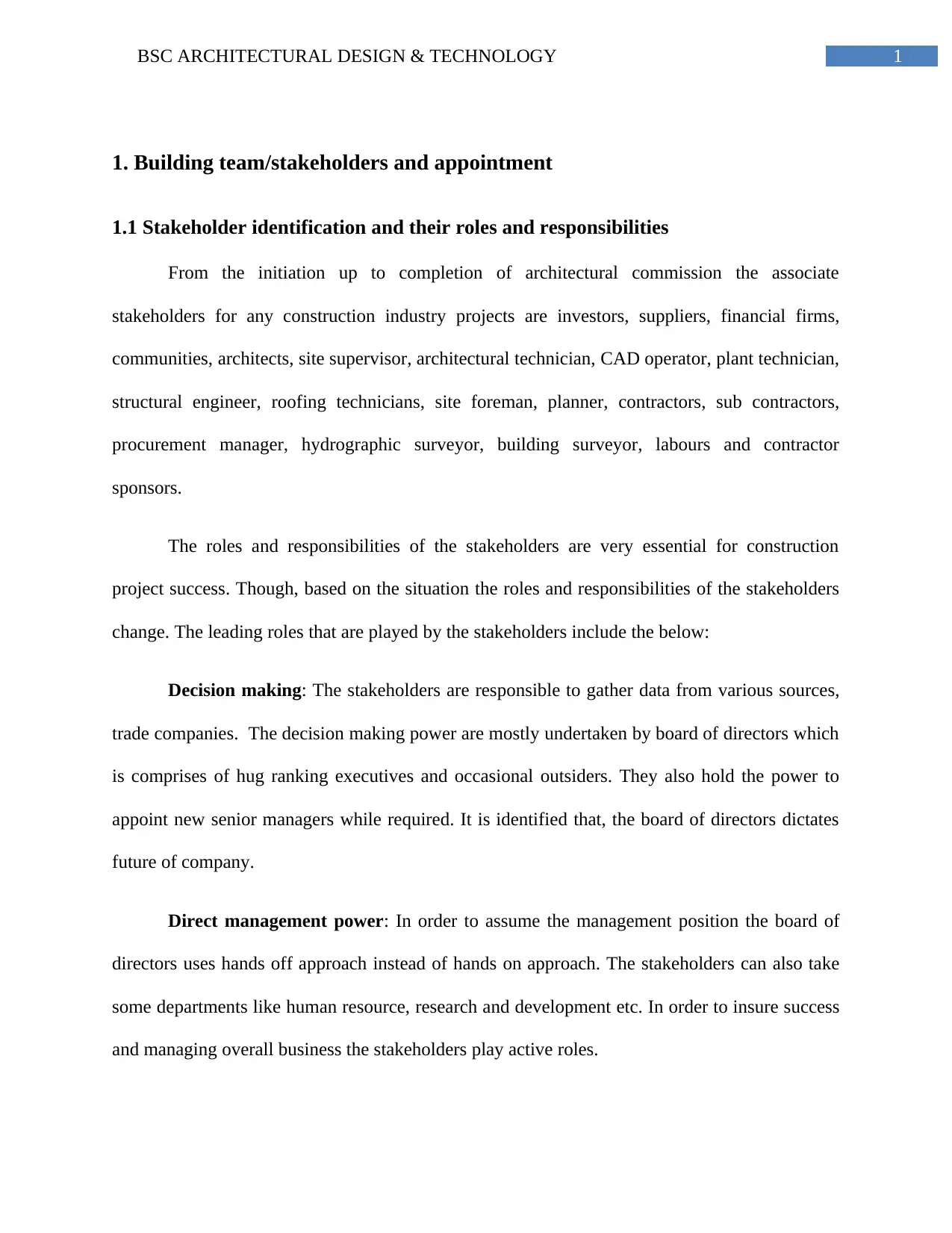
1BSC ARCHITECTURAL DESIGN & TECHNOLOGY
1. Building team/stakeholders and appointment
1.1 Stakeholder identification and their roles and responsibilities
From the initiation up to completion of architectural commission the associate
stakeholders for any construction industry projects are investors, suppliers, financial firms,
communities, architects, site supervisor, architectural technician, CAD operator, plant technician,
structural engineer, roofing technicians, site foreman, planner, contractors, sub contractors,
procurement manager, hydrographic surveyor, building surveyor, labours and contractor
sponsors.
The roles and responsibilities of the stakeholders are very essential for construction
project success. Though, based on the situation the roles and responsibilities of the stakeholders
change. The leading roles that are played by the stakeholders include the below:
Decision making: The stakeholders are responsible to gather data from various sources,
trade companies. The decision making power are mostly undertaken by board of directors which
is comprises of hug ranking executives and occasional outsiders. They also hold the power to
appoint new senior managers while required. It is identified that, the board of directors dictates
future of company.
Direct management power: In order to assume the management position the board of
directors uses hands off approach instead of hands on approach. The stakeholders can also take
some departments like human resource, research and development etc. In order to insure success
and managing overall business the stakeholders play active roles.
1. Building team/stakeholders and appointment
1.1 Stakeholder identification and their roles and responsibilities
From the initiation up to completion of architectural commission the associate
stakeholders for any construction industry projects are investors, suppliers, financial firms,
communities, architects, site supervisor, architectural technician, CAD operator, plant technician,
structural engineer, roofing technicians, site foreman, planner, contractors, sub contractors,
procurement manager, hydrographic surveyor, building surveyor, labours and contractor
sponsors.
The roles and responsibilities of the stakeholders are very essential for construction
project success. Though, based on the situation the roles and responsibilities of the stakeholders
change. The leading roles that are played by the stakeholders include the below:
Decision making: The stakeholders are responsible to gather data from various sources,
trade companies. The decision making power are mostly undertaken by board of directors which
is comprises of hug ranking executives and occasional outsiders. They also hold the power to
appoint new senior managers while required. It is identified that, the board of directors dictates
future of company.
Direct management power: In order to assume the management position the board of
directors uses hands off approach instead of hands on approach. The stakeholders can also take
some departments like human resource, research and development etc. In order to insure success
and managing overall business the stakeholders play active roles.
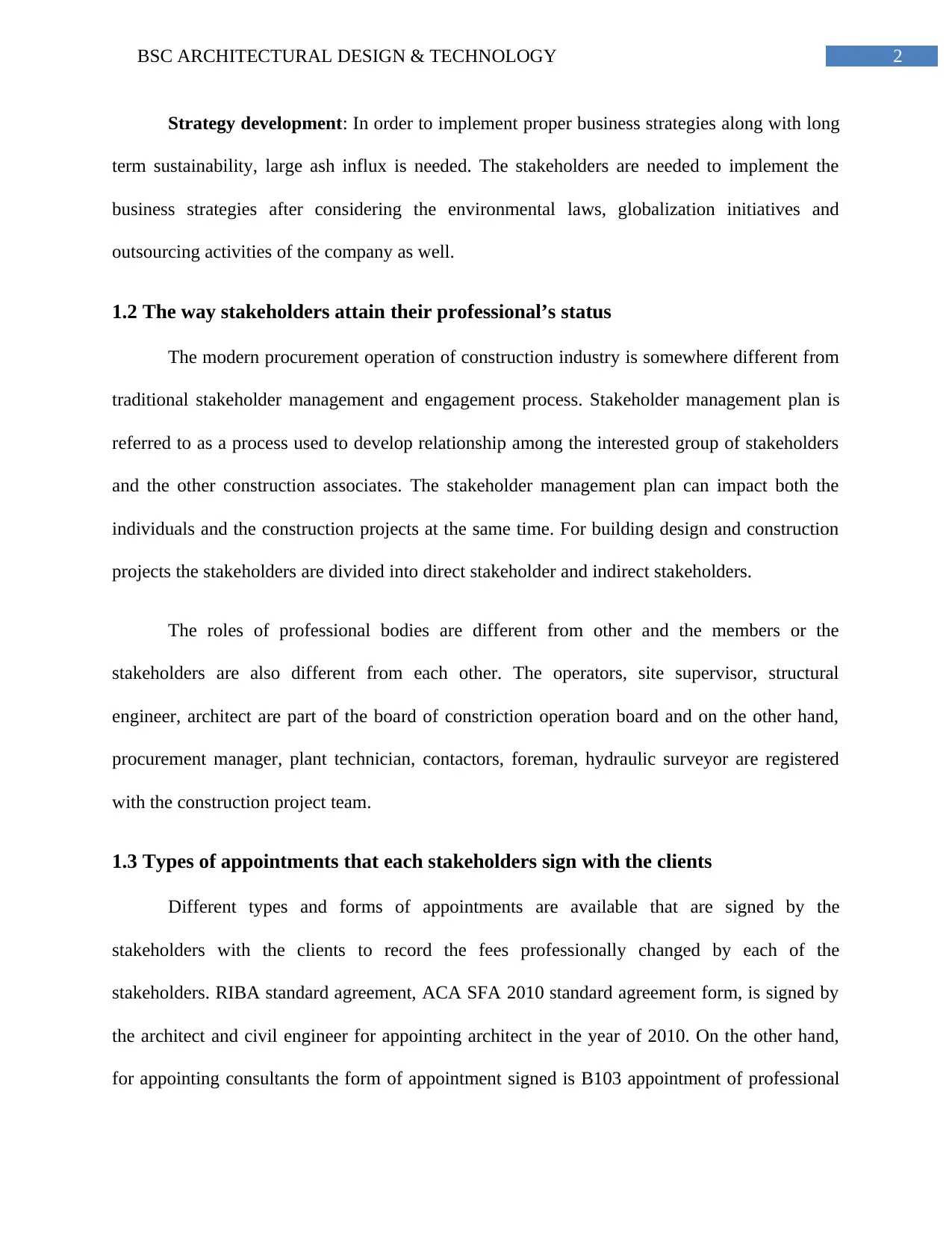
2BSC ARCHITECTURAL DESIGN & TECHNOLOGY
Strategy development: In order to implement proper business strategies along with long
term sustainability, large ash influx is needed. The stakeholders are needed to implement the
business strategies after considering the environmental laws, globalization initiatives and
outsourcing activities of the company as well.
1.2 The way stakeholders attain their professional’s status
The modern procurement operation of construction industry is somewhere different from
traditional stakeholder management and engagement process. Stakeholder management plan is
referred to as a process used to develop relationship among the interested group of stakeholders
and the other construction associates. The stakeholder management plan can impact both the
individuals and the construction projects at the same time. For building design and construction
projects the stakeholders are divided into direct stakeholder and indirect stakeholders.
The roles of professional bodies are different from other and the members or the
stakeholders are also different from each other. The operators, site supervisor, structural
engineer, architect are part of the board of constriction operation board and on the other hand,
procurement manager, plant technician, contactors, foreman, hydraulic surveyor are registered
with the construction project team.
1.3 Types of appointments that each stakeholders sign with the clients
Different types and forms of appointments are available that are signed by the
stakeholders with the clients to record the fees professionally changed by each of the
stakeholders. RIBA standard agreement, ACA SFA 2010 standard agreement form, is signed by
the architect and civil engineer for appointing architect in the year of 2010. On the other hand,
for appointing consultants the form of appointment signed is B103 appointment of professional
Strategy development: In order to implement proper business strategies along with long
term sustainability, large ash influx is needed. The stakeholders are needed to implement the
business strategies after considering the environmental laws, globalization initiatives and
outsourcing activities of the company as well.
1.2 The way stakeholders attain their professional’s status
The modern procurement operation of construction industry is somewhere different from
traditional stakeholder management and engagement process. Stakeholder management plan is
referred to as a process used to develop relationship among the interested group of stakeholders
and the other construction associates. The stakeholder management plan can impact both the
individuals and the construction projects at the same time. For building design and construction
projects the stakeholders are divided into direct stakeholder and indirect stakeholders.
The roles of professional bodies are different from other and the members or the
stakeholders are also different from each other. The operators, site supervisor, structural
engineer, architect are part of the board of constriction operation board and on the other hand,
procurement manager, plant technician, contactors, foreman, hydraulic surveyor are registered
with the construction project team.
1.3 Types of appointments that each stakeholders sign with the clients
Different types and forms of appointments are available that are signed by the
stakeholders with the clients to record the fees professionally changed by each of the
stakeholders. RIBA standard agreement, ACA SFA 2010 standard agreement form, is signed by
the architect and civil engineer for appointing architect in the year of 2010. On the other hand,
for appointing consultants the form of appointment signed is B103 appointment of professional
⊘ This is a preview!⊘
Do you want full access?
Subscribe today to unlock all pages.

Trusted by 1+ million students worldwide
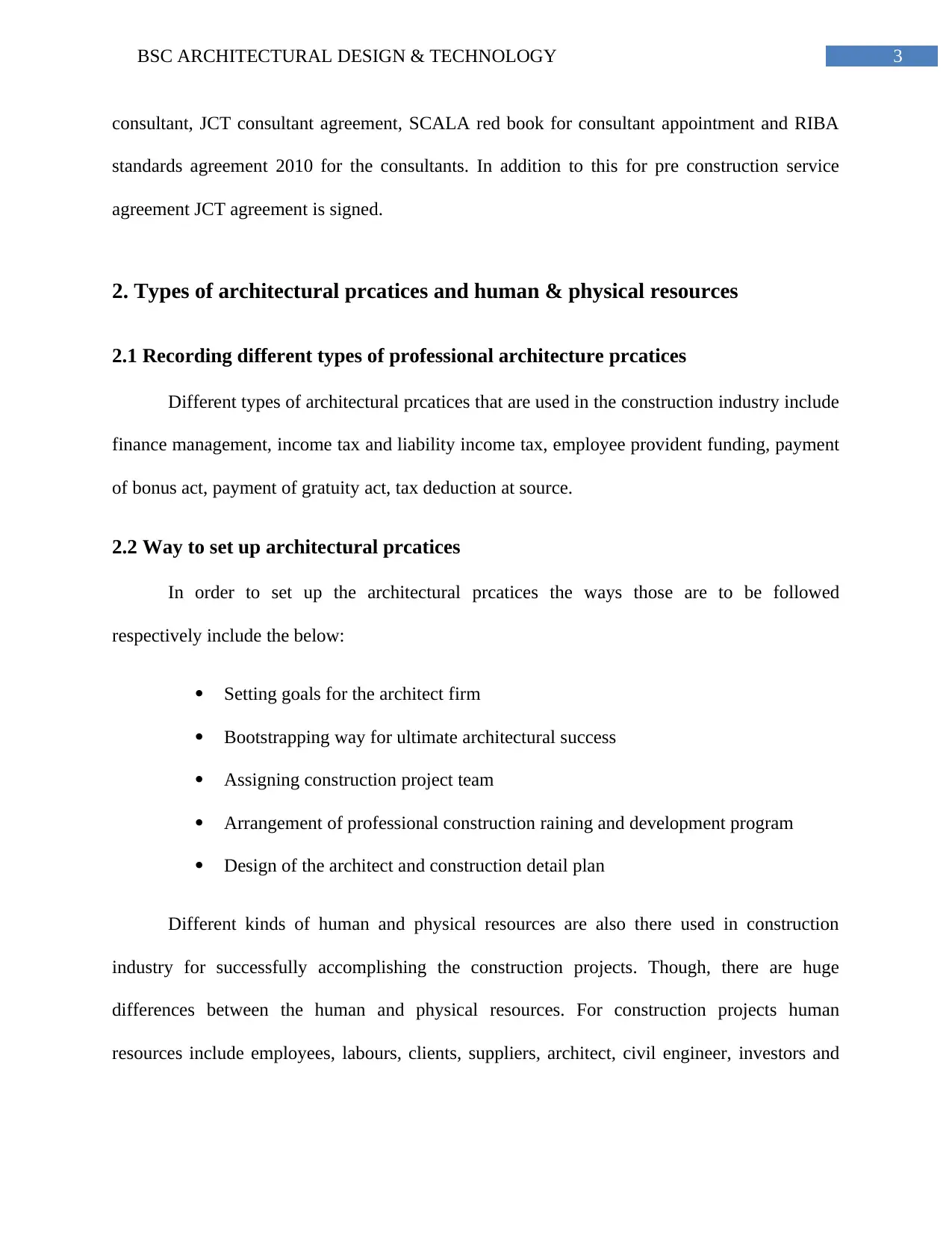
3BSC ARCHITECTURAL DESIGN & TECHNOLOGY
consultant, JCT consultant agreement, SCALA red book for consultant appointment and RIBA
standards agreement 2010 for the consultants. In addition to this for pre construction service
agreement JCT agreement is signed.
2. Types of architectural prcatices and human & physical resources
2.1 Recording different types of professional architecture prcatices
Different types of architectural prcatices that are used in the construction industry include
finance management, income tax and liability income tax, employee provident funding, payment
of bonus act, payment of gratuity act, tax deduction at source.
2.2 Way to set up architectural prcatices
In order to set up the architectural prcatices the ways those are to be followed
respectively include the below:
Setting goals for the architect firm
Bootstrapping way for ultimate architectural success
Assigning construction project team
Arrangement of professional construction raining and development program
Design of the architect and construction detail plan
Different kinds of human and physical resources are also there used in construction
industry for successfully accomplishing the construction projects. Though, there are huge
differences between the human and physical resources. For construction projects human
resources include employees, labours, clients, suppliers, architect, civil engineer, investors and
consultant, JCT consultant agreement, SCALA red book for consultant appointment and RIBA
standards agreement 2010 for the consultants. In addition to this for pre construction service
agreement JCT agreement is signed.
2. Types of architectural prcatices and human & physical resources
2.1 Recording different types of professional architecture prcatices
Different types of architectural prcatices that are used in the construction industry include
finance management, income tax and liability income tax, employee provident funding, payment
of bonus act, payment of gratuity act, tax deduction at source.
2.2 Way to set up architectural prcatices
In order to set up the architectural prcatices the ways those are to be followed
respectively include the below:
Setting goals for the architect firm
Bootstrapping way for ultimate architectural success
Assigning construction project team
Arrangement of professional construction raining and development program
Design of the architect and construction detail plan
Different kinds of human and physical resources are also there used in construction
industry for successfully accomplishing the construction projects. Though, there are huge
differences between the human and physical resources. For construction projects human
resources include employees, labours, clients, suppliers, architect, civil engineer, investors and
Paraphrase This Document
Need a fresh take? Get an instant paraphrase of this document with our AI Paraphraser
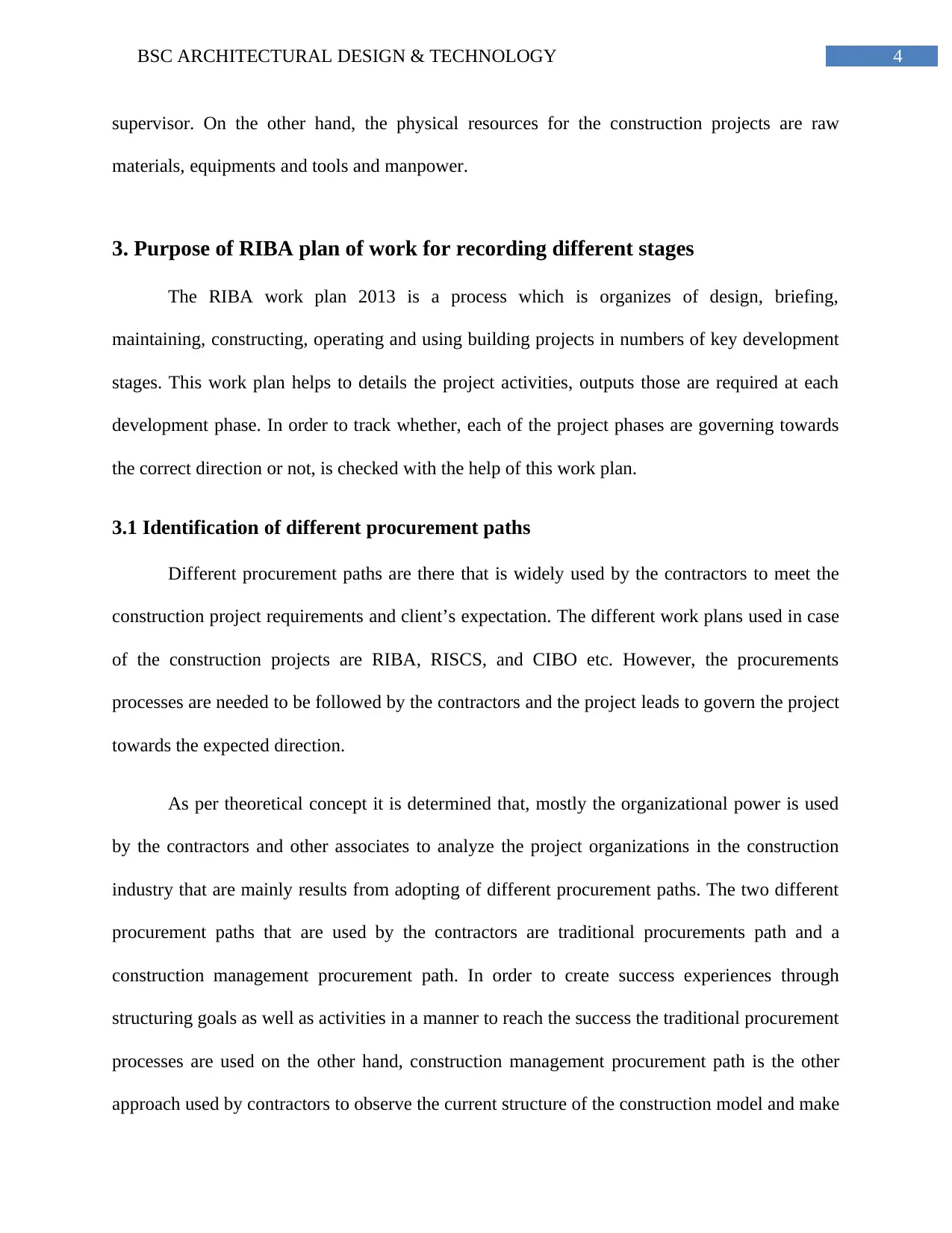
4BSC ARCHITECTURAL DESIGN & TECHNOLOGY
supervisor. On the other hand, the physical resources for the construction projects are raw
materials, equipments and tools and manpower.
3. Purpose of RIBA plan of work for recording different stages
The RIBA work plan 2013 is a process which is organizes of design, briefing,
maintaining, constructing, operating and using building projects in numbers of key development
stages. This work plan helps to details the project activities, outputs those are required at each
development phase. In order to track whether, each of the project phases are governing towards
the correct direction or not, is checked with the help of this work plan.
3.1 Identification of different procurement paths
Different procurement paths are there that is widely used by the contractors to meet the
construction project requirements and client’s expectation. The different work plans used in case
of the construction projects are RIBA, RISCS, and CIBO etc. However, the procurements
processes are needed to be followed by the contractors and the project leads to govern the project
towards the expected direction.
As per theoretical concept it is determined that, mostly the organizational power is used
by the contractors and other associates to analyze the project organizations in the construction
industry that are mainly results from adopting of different procurement paths. The two different
procurement paths that are used by the contractors are traditional procurements path and a
construction management procurement path. In order to create success experiences through
structuring goals as well as activities in a manner to reach the success the traditional procurement
processes are used on the other hand, construction management procurement path is the other
approach used by contractors to observe the current structure of the construction model and make
supervisor. On the other hand, the physical resources for the construction projects are raw
materials, equipments and tools and manpower.
3. Purpose of RIBA plan of work for recording different stages
The RIBA work plan 2013 is a process which is organizes of design, briefing,
maintaining, constructing, operating and using building projects in numbers of key development
stages. This work plan helps to details the project activities, outputs those are required at each
development phase. In order to track whether, each of the project phases are governing towards
the correct direction or not, is checked with the help of this work plan.
3.1 Identification of different procurement paths
Different procurement paths are there that is widely used by the contractors to meet the
construction project requirements and client’s expectation. The different work plans used in case
of the construction projects are RIBA, RISCS, and CIBO etc. However, the procurements
processes are needed to be followed by the contractors and the project leads to govern the project
towards the expected direction.
As per theoretical concept it is determined that, mostly the organizational power is used
by the contractors and other associates to analyze the project organizations in the construction
industry that are mainly results from adopting of different procurement paths. The two different
procurement paths that are used by the contractors are traditional procurements path and a
construction management procurement path. In order to create success experiences through
structuring goals as well as activities in a manner to reach the success the traditional procurement
processes are used on the other hand, construction management procurement path is the other
approach used by contractors to observe the current structure of the construction model and make
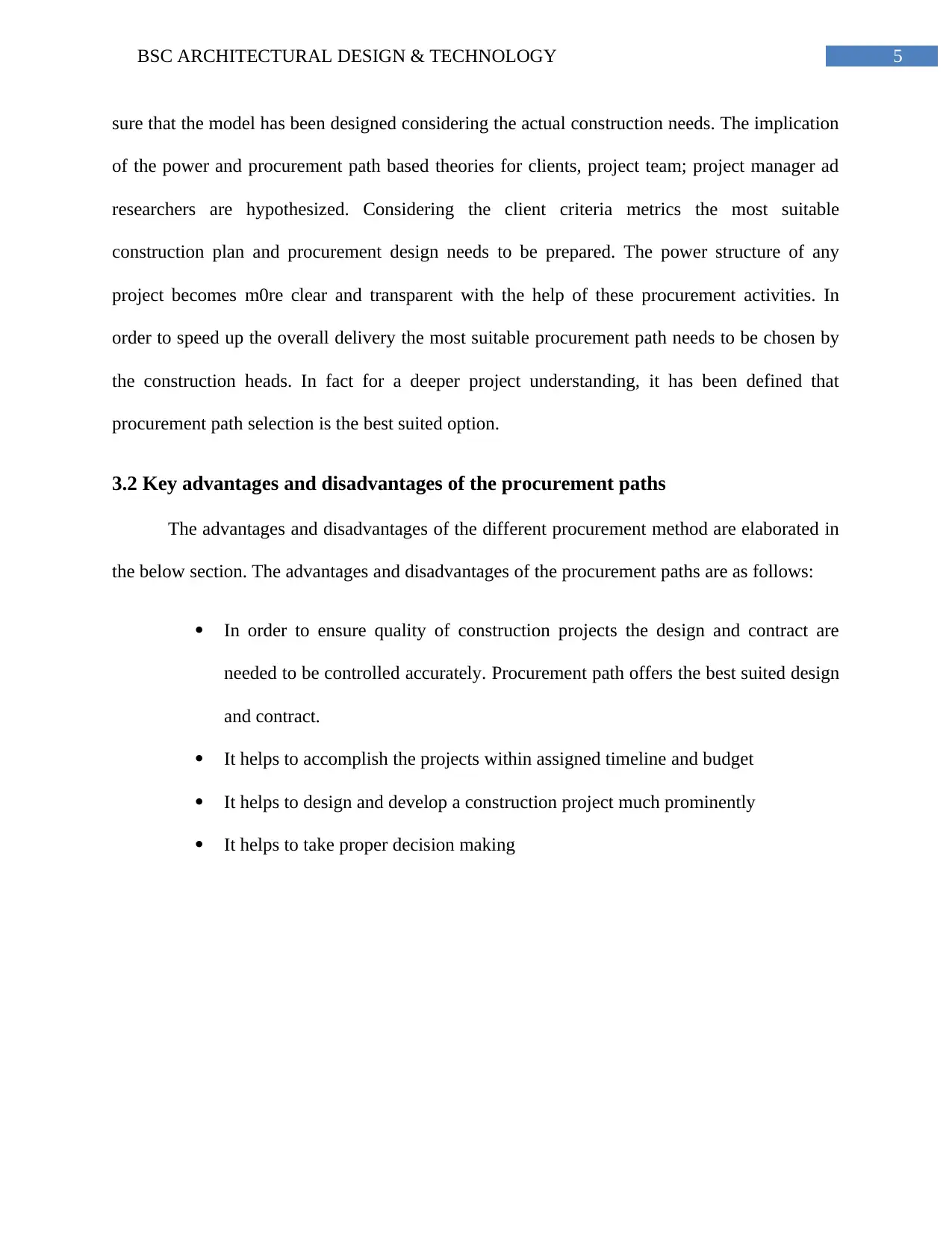
5BSC ARCHITECTURAL DESIGN & TECHNOLOGY
sure that the model has been designed considering the actual construction needs. The implication
of the power and procurement path based theories for clients, project team; project manager ad
researchers are hypothesized. Considering the client criteria metrics the most suitable
construction plan and procurement design needs to be prepared. The power structure of any
project becomes m0re clear and transparent with the help of these procurement activities. In
order to speed up the overall delivery the most suitable procurement path needs to be chosen by
the construction heads. In fact for a deeper project understanding, it has been defined that
procurement path selection is the best suited option.
3.2 Key advantages and disadvantages of the procurement paths
The advantages and disadvantages of the different procurement method are elaborated in
the below section. The advantages and disadvantages of the procurement paths are as follows:
In order to ensure quality of construction projects the design and contract are
needed to be controlled accurately. Procurement path offers the best suited design
and contract.
It helps to accomplish the projects within assigned timeline and budget
It helps to design and develop a construction project much prominently
It helps to take proper decision making
sure that the model has been designed considering the actual construction needs. The implication
of the power and procurement path based theories for clients, project team; project manager ad
researchers are hypothesized. Considering the client criteria metrics the most suitable
construction plan and procurement design needs to be prepared. The power structure of any
project becomes m0re clear and transparent with the help of these procurement activities. In
order to speed up the overall delivery the most suitable procurement path needs to be chosen by
the construction heads. In fact for a deeper project understanding, it has been defined that
procurement path selection is the best suited option.
3.2 Key advantages and disadvantages of the procurement paths
The advantages and disadvantages of the different procurement method are elaborated in
the below section. The advantages and disadvantages of the procurement paths are as follows:
In order to ensure quality of construction projects the design and contract are
needed to be controlled accurately. Procurement path offers the best suited design
and contract.
It helps to accomplish the projects within assigned timeline and budget
It helps to design and develop a construction project much prominently
It helps to take proper decision making
⊘ This is a preview!⊘
Do you want full access?
Subscribe today to unlock all pages.

Trusted by 1+ million students worldwide
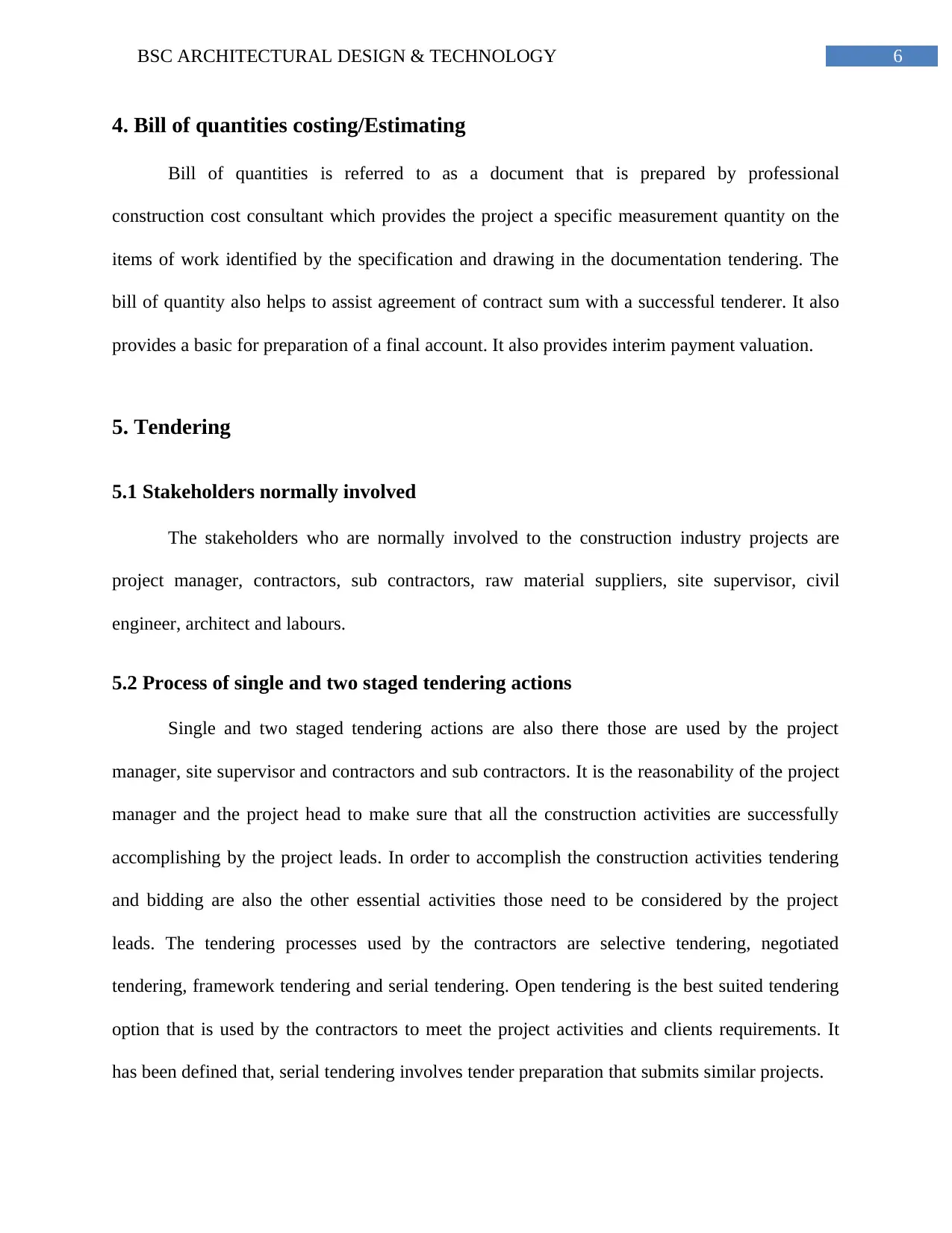
6BSC ARCHITECTURAL DESIGN & TECHNOLOGY
4. Bill of quantities costing/Estimating
Bill of quantities is referred to as a document that is prepared by professional
construction cost consultant which provides the project a specific measurement quantity on the
items of work identified by the specification and drawing in the documentation tendering. The
bill of quantity also helps to assist agreement of contract sum with a successful tenderer. It also
provides a basic for preparation of a final account. It also provides interim payment valuation.
5. Tendering
5.1 Stakeholders normally involved
The stakeholders who are normally involved to the construction industry projects are
project manager, contractors, sub contractors, raw material suppliers, site supervisor, civil
engineer, architect and labours.
5.2 Process of single and two staged tendering actions
Single and two staged tendering actions are also there those are used by the project
manager, site supervisor and contractors and sub contractors. It is the reasonability of the project
manager and the project head to make sure that all the construction activities are successfully
accomplishing by the project leads. In order to accomplish the construction activities tendering
and bidding are also the other essential activities those need to be considered by the project
leads. The tendering processes used by the contractors are selective tendering, negotiated
tendering, framework tendering and serial tendering. Open tendering is the best suited tendering
option that is used by the contractors to meet the project activities and clients requirements. It
has been defined that, serial tendering involves tender preparation that submits similar projects.
4. Bill of quantities costing/Estimating
Bill of quantities is referred to as a document that is prepared by professional
construction cost consultant which provides the project a specific measurement quantity on the
items of work identified by the specification and drawing in the documentation tendering. The
bill of quantity also helps to assist agreement of contract sum with a successful tenderer. It also
provides a basic for preparation of a final account. It also provides interim payment valuation.
5. Tendering
5.1 Stakeholders normally involved
The stakeholders who are normally involved to the construction industry projects are
project manager, contractors, sub contractors, raw material suppliers, site supervisor, civil
engineer, architect and labours.
5.2 Process of single and two staged tendering actions
Single and two staged tendering actions are also there those are used by the project
manager, site supervisor and contractors and sub contractors. It is the reasonability of the project
manager and the project head to make sure that all the construction activities are successfully
accomplishing by the project leads. In order to accomplish the construction activities tendering
and bidding are also the other essential activities those need to be considered by the project
leads. The tendering processes used by the contractors are selective tendering, negotiated
tendering, framework tendering and serial tendering. Open tendering is the best suited tendering
option that is used by the contractors to meet the project activities and clients requirements. It
has been defined that, serial tendering involves tender preparation that submits similar projects.
Paraphrase This Document
Need a fresh take? Get an instant paraphrase of this document with our AI Paraphraser
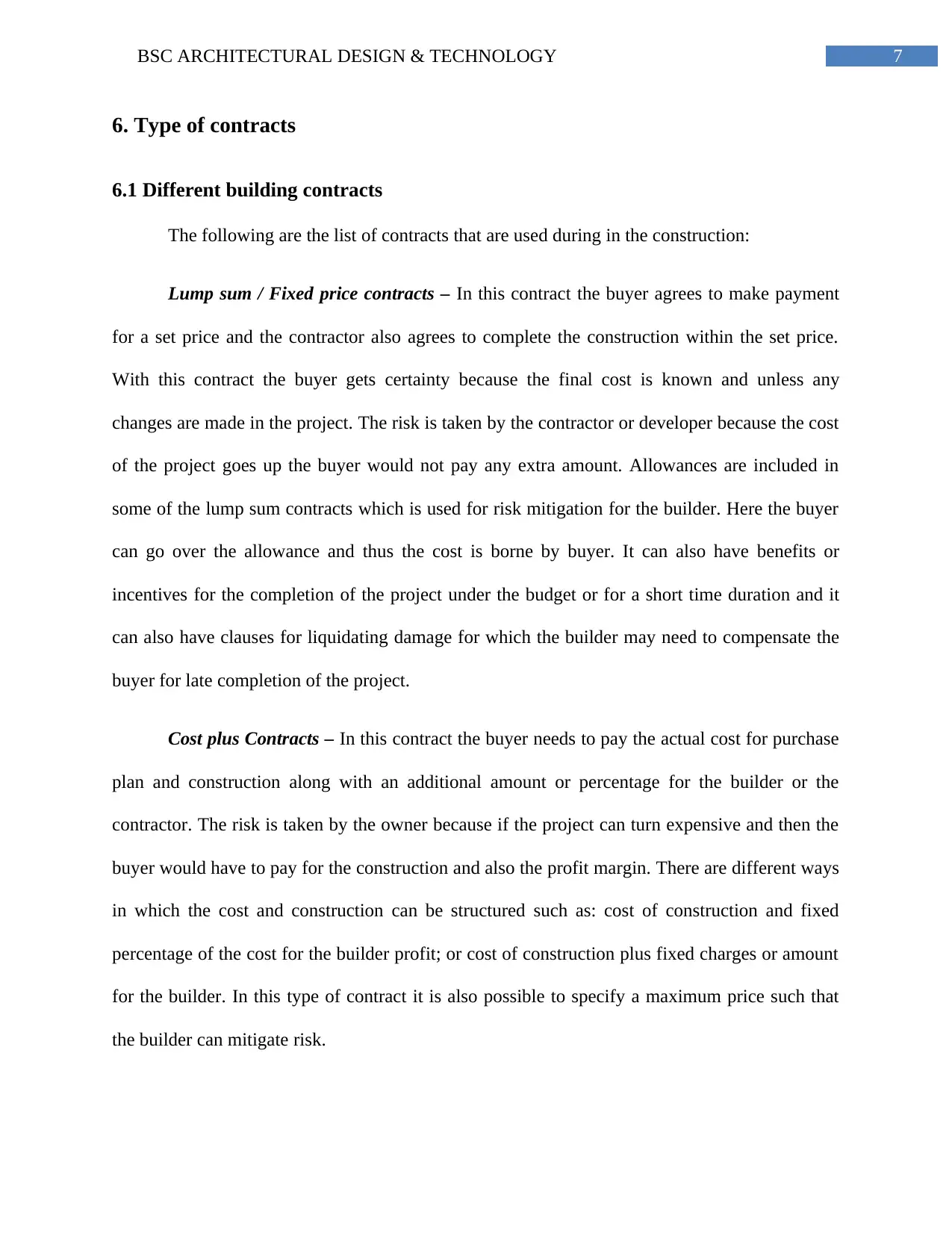
7BSC ARCHITECTURAL DESIGN & TECHNOLOGY
6. Type of contracts
6.1 Different building contracts
The following are the list of contracts that are used during in the construction:
Lump sum / Fixed price contracts – In this contract the buyer agrees to make payment
for a set price and the contractor also agrees to complete the construction within the set price.
With this contract the buyer gets certainty because the final cost is known and unless any
changes are made in the project. The risk is taken by the contractor or developer because the cost
of the project goes up the buyer would not pay any extra amount. Allowances are included in
some of the lump sum contracts which is used for risk mitigation for the builder. Here the buyer
can go over the allowance and thus the cost is borne by buyer. It can also have benefits or
incentives for the completion of the project under the budget or for a short time duration and it
can also have clauses for liquidating damage for which the builder may need to compensate the
buyer for late completion of the project.
Cost plus Contracts – In this contract the buyer needs to pay the actual cost for purchase
plan and construction along with an additional amount or percentage for the builder or the
contractor. The risk is taken by the owner because if the project can turn expensive and then the
buyer would have to pay for the construction and also the profit margin. There are different ways
in which the cost and construction can be structured such as: cost of construction and fixed
percentage of the cost for the builder profit; or cost of construction plus fixed charges or amount
for the builder. In this type of contract it is also possible to specify a maximum price such that
the builder can mitigate risk.
6. Type of contracts
6.1 Different building contracts
The following are the list of contracts that are used during in the construction:
Lump sum / Fixed price contracts – In this contract the buyer agrees to make payment
for a set price and the contractor also agrees to complete the construction within the set price.
With this contract the buyer gets certainty because the final cost is known and unless any
changes are made in the project. The risk is taken by the contractor or developer because the cost
of the project goes up the buyer would not pay any extra amount. Allowances are included in
some of the lump sum contracts which is used for risk mitigation for the builder. Here the buyer
can go over the allowance and thus the cost is borne by buyer. It can also have benefits or
incentives for the completion of the project under the budget or for a short time duration and it
can also have clauses for liquidating damage for which the builder may need to compensate the
buyer for late completion of the project.
Cost plus Contracts – In this contract the buyer needs to pay the actual cost for purchase
plan and construction along with an additional amount or percentage for the builder or the
contractor. The risk is taken by the owner because if the project can turn expensive and then the
buyer would have to pay for the construction and also the profit margin. There are different ways
in which the cost and construction can be structured such as: cost of construction and fixed
percentage of the cost for the builder profit; or cost of construction plus fixed charges or amount
for the builder. In this type of contract it is also possible to specify a maximum price such that
the builder can mitigate risk.
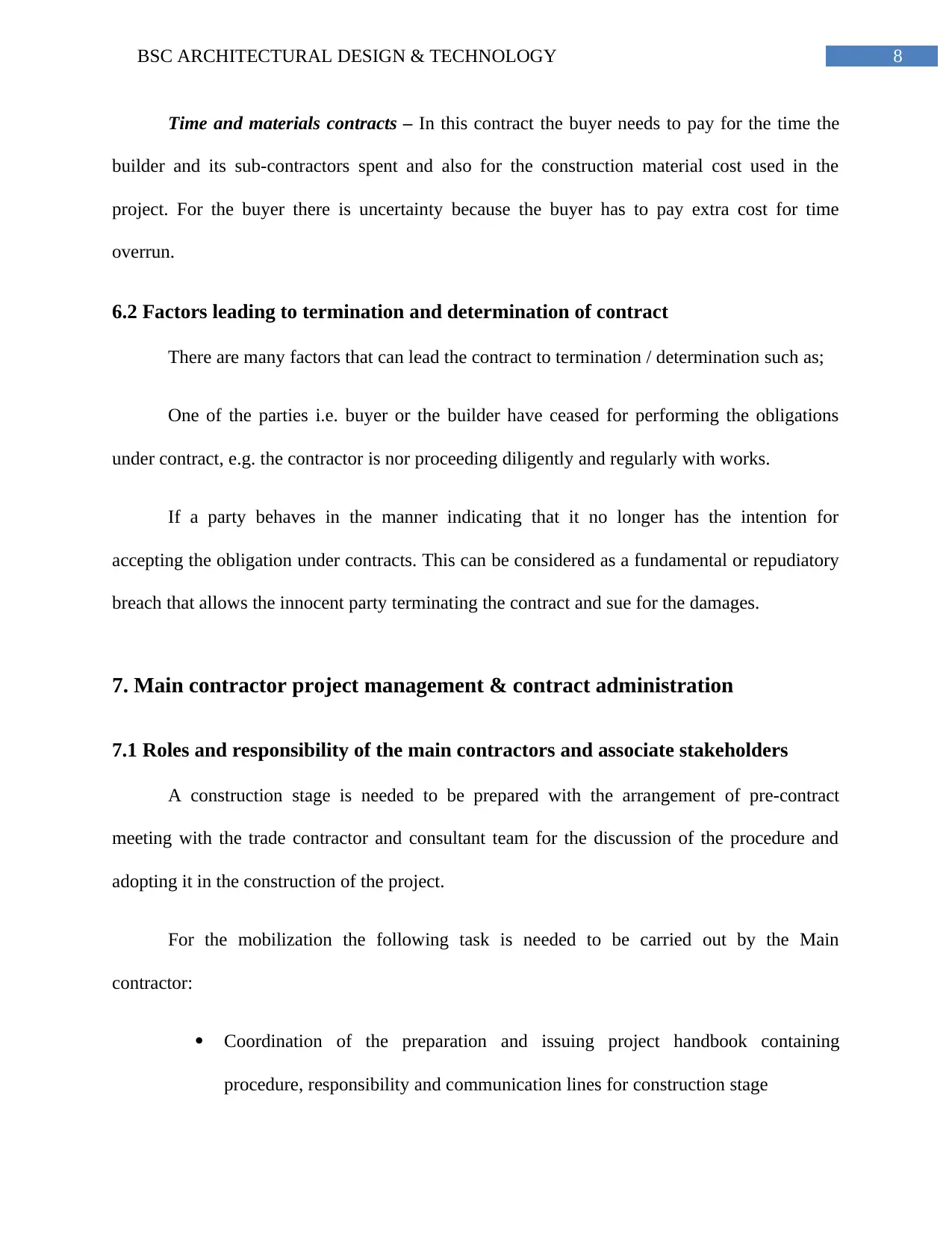
8BSC ARCHITECTURAL DESIGN & TECHNOLOGY
Time and materials contracts – In this contract the buyer needs to pay for the time the
builder and its sub-contractors spent and also for the construction material cost used in the
project. For the buyer there is uncertainty because the buyer has to pay extra cost for time
overrun.
6.2 Factors leading to termination and determination of contract
There are many factors that can lead the contract to termination / determination such as;
One of the parties i.e. buyer or the builder have ceased for performing the obligations
under contract, e.g. the contractor is nor proceeding diligently and regularly with works.
If a party behaves in the manner indicating that it no longer has the intention for
accepting the obligation under contracts. This can be considered as a fundamental or repudiatory
breach that allows the innocent party terminating the contract and sue for the damages.
7. Main contractor project management & contract administration
7.1 Roles and responsibility of the main contractors and associate stakeholders
A construction stage is needed to be prepared with the arrangement of pre-contract
meeting with the trade contractor and consultant team for the discussion of the procedure and
adopting it in the construction of the project.
For the mobilization the following task is needed to be carried out by the Main
contractor:
Coordination of the preparation and issuing project handbook containing
procedure, responsibility and communication lines for construction stage
Time and materials contracts – In this contract the buyer needs to pay for the time the
builder and its sub-contractors spent and also for the construction material cost used in the
project. For the buyer there is uncertainty because the buyer has to pay extra cost for time
overrun.
6.2 Factors leading to termination and determination of contract
There are many factors that can lead the contract to termination / determination such as;
One of the parties i.e. buyer or the builder have ceased for performing the obligations
under contract, e.g. the contractor is nor proceeding diligently and regularly with works.
If a party behaves in the manner indicating that it no longer has the intention for
accepting the obligation under contracts. This can be considered as a fundamental or repudiatory
breach that allows the innocent party terminating the contract and sue for the damages.
7. Main contractor project management & contract administration
7.1 Roles and responsibility of the main contractors and associate stakeholders
A construction stage is needed to be prepared with the arrangement of pre-contract
meeting with the trade contractor and consultant team for the discussion of the procedure and
adopting it in the construction of the project.
For the mobilization the following task is needed to be carried out by the Main
contractor:
Coordination of the preparation and issuing project handbook containing
procedure, responsibility and communication lines for construction stage
⊘ This is a preview!⊘
Do you want full access?
Subscribe today to unlock all pages.

Trusted by 1+ million students worldwide
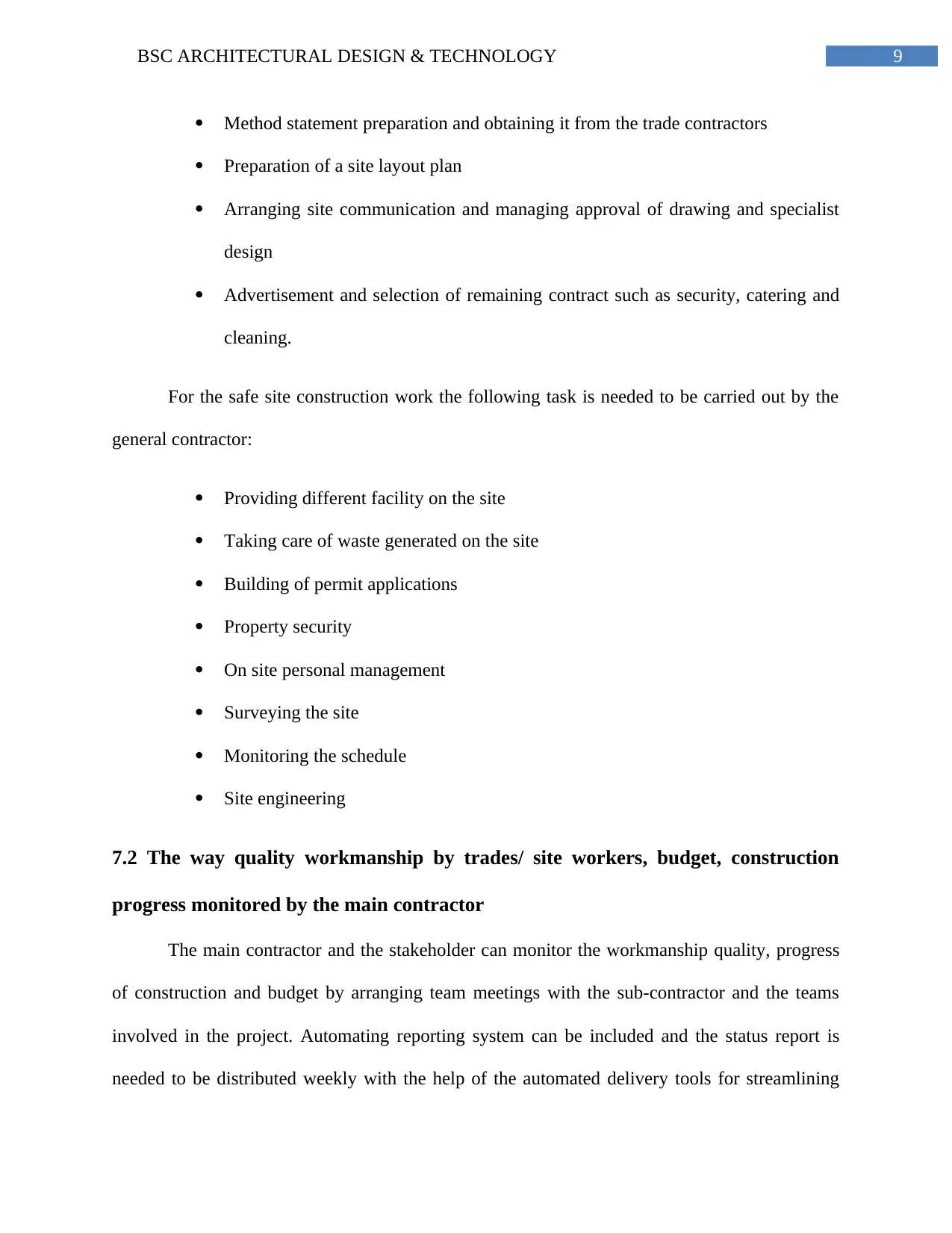
9BSC ARCHITECTURAL DESIGN & TECHNOLOGY
Method statement preparation and obtaining it from the trade contractors
Preparation of a site layout plan
Arranging site communication and managing approval of drawing and specialist
design
Advertisement and selection of remaining contract such as security, catering and
cleaning.
For the safe site construction work the following task is needed to be carried out by the
general contractor:
Providing different facility on the site
Taking care of waste generated on the site
Building of permit applications
Property security
On site personal management
Surveying the site
Monitoring the schedule
Site engineering
7.2 The way quality workmanship by trades/ site workers, budget, construction
progress monitored by the main contractor
The main contractor and the stakeholder can monitor the workmanship quality, progress
of construction and budget by arranging team meetings with the sub-contractor and the teams
involved in the project. Automating reporting system can be included and the status report is
needed to be distributed weekly with the help of the automated delivery tools for streamlining
Method statement preparation and obtaining it from the trade contractors
Preparation of a site layout plan
Arranging site communication and managing approval of drawing and specialist
design
Advertisement and selection of remaining contract such as security, catering and
cleaning.
For the safe site construction work the following task is needed to be carried out by the
general contractor:
Providing different facility on the site
Taking care of waste generated on the site
Building of permit applications
Property security
On site personal management
Surveying the site
Monitoring the schedule
Site engineering
7.2 The way quality workmanship by trades/ site workers, budget, construction
progress monitored by the main contractor
The main contractor and the stakeholder can monitor the workmanship quality, progress
of construction and budget by arranging team meetings with the sub-contractor and the teams
involved in the project. Automating reporting system can be included and the status report is
needed to be distributed weekly with the help of the automated delivery tools for streamlining
Paraphrase This Document
Need a fresh take? Get an instant paraphrase of this document with our AI Paraphraser
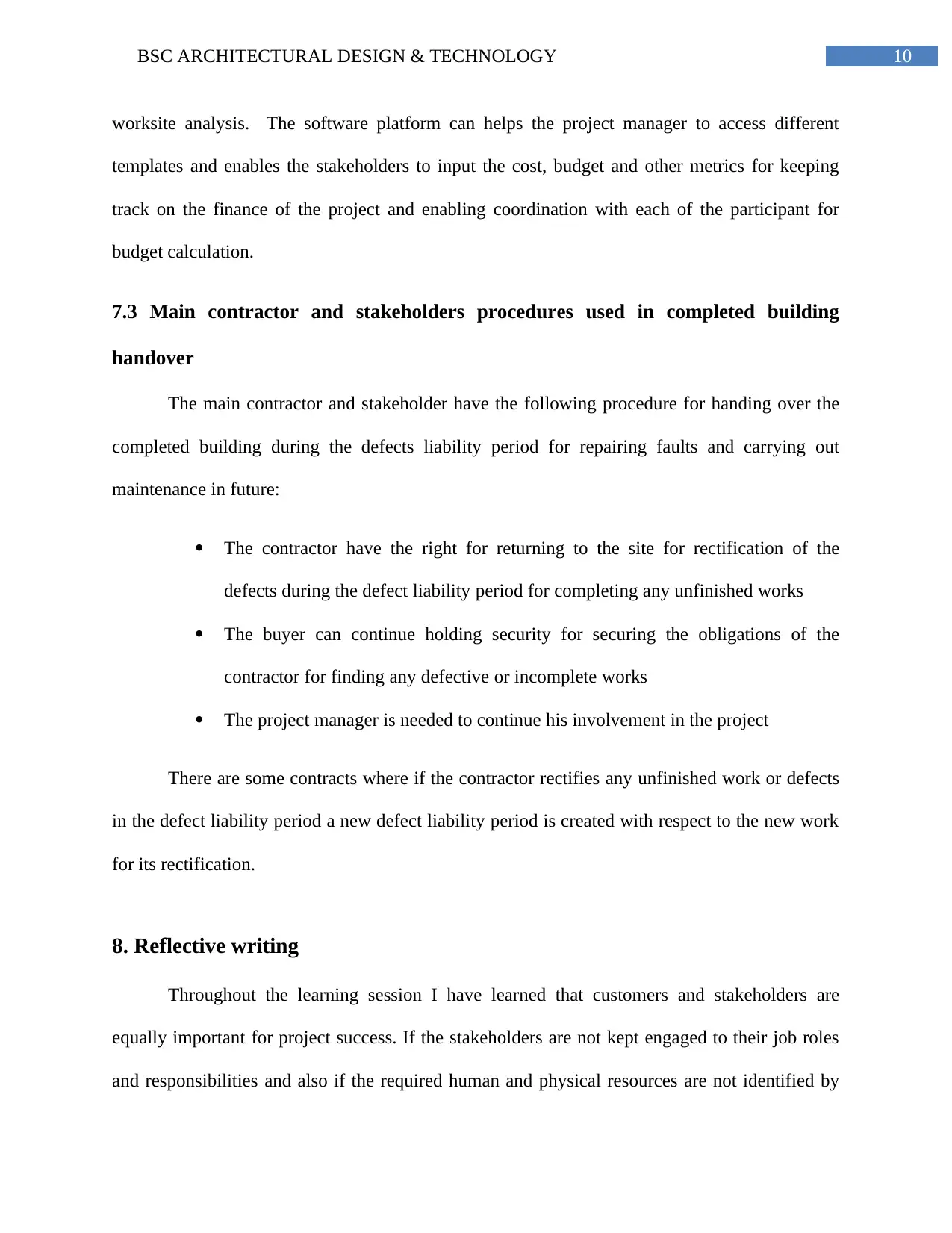
10BSC ARCHITECTURAL DESIGN & TECHNOLOGY
worksite analysis. The software platform can helps the project manager to access different
templates and enables the stakeholders to input the cost, budget and other metrics for keeping
track on the finance of the project and enabling coordination with each of the participant for
budget calculation.
7.3 Main contractor and stakeholders procedures used in completed building
handover
The main contractor and stakeholder have the following procedure for handing over the
completed building during the defects liability period for repairing faults and carrying out
maintenance in future:
The contractor have the right for returning to the site for rectification of the
defects during the defect liability period for completing any unfinished works
The buyer can continue holding security for securing the obligations of the
contractor for finding any defective or incomplete works
The project manager is needed to continue his involvement in the project
There are some contracts where if the contractor rectifies any unfinished work or defects
in the defect liability period a new defect liability period is created with respect to the new work
for its rectification.
8. Reflective writing
Throughout the learning session I have learned that customers and stakeholders are
equally important for project success. If the stakeholders are not kept engaged to their job roles
and responsibilities and also if the required human and physical resources are not identified by
worksite analysis. The software platform can helps the project manager to access different
templates and enables the stakeholders to input the cost, budget and other metrics for keeping
track on the finance of the project and enabling coordination with each of the participant for
budget calculation.
7.3 Main contractor and stakeholders procedures used in completed building
handover
The main contractor and stakeholder have the following procedure for handing over the
completed building during the defects liability period for repairing faults and carrying out
maintenance in future:
The contractor have the right for returning to the site for rectification of the
defects during the defect liability period for completing any unfinished works
The buyer can continue holding security for securing the obligations of the
contractor for finding any defective or incomplete works
The project manager is needed to continue his involvement in the project
There are some contracts where if the contractor rectifies any unfinished work or defects
in the defect liability period a new defect liability period is created with respect to the new work
for its rectification.
8. Reflective writing
Throughout the learning session I have learned that customers and stakeholders are
equally important for project success. If the stakeholders are not kept engaged to their job roles
and responsibilities and also if the required human and physical resources are not identified by
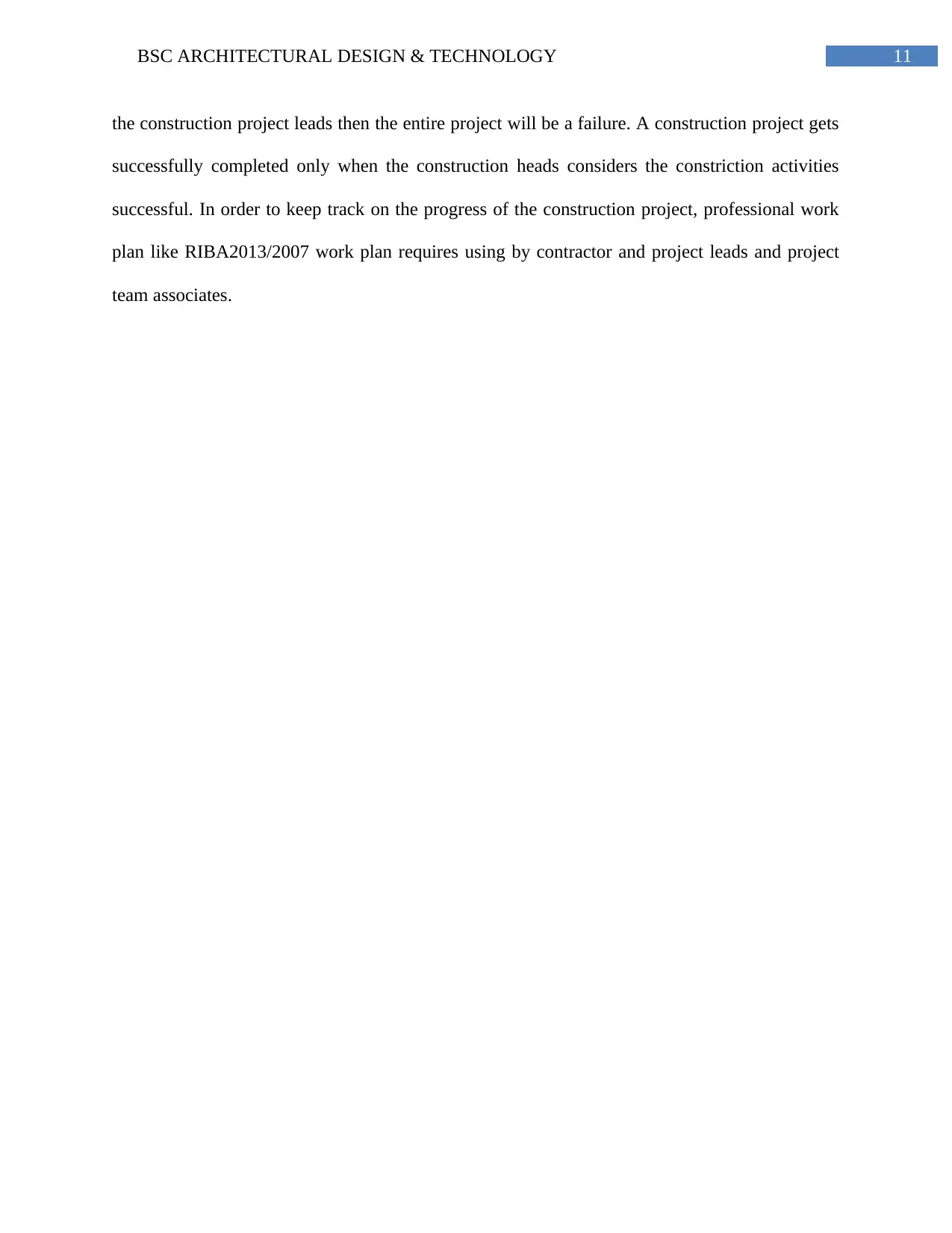
11BSC ARCHITECTURAL DESIGN & TECHNOLOGY
the construction project leads then the entire project will be a failure. A construction project gets
successfully completed only when the construction heads considers the constriction activities
successful. In order to keep track on the progress of the construction project, professional work
plan like RIBA2013/2007 work plan requires using by contractor and project leads and project
team associates.
the construction project leads then the entire project will be a failure. A construction project gets
successfully completed only when the construction heads considers the constriction activities
successful. In order to keep track on the progress of the construction project, professional work
plan like RIBA2013/2007 work plan requires using by contractor and project leads and project
team associates.
⊘ This is a preview!⊘
Do you want full access?
Subscribe today to unlock all pages.

Trusted by 1+ million students worldwide
1 out of 14
Related Documents
Your All-in-One AI-Powered Toolkit for Academic Success.
+13062052269
info@desklib.com
Available 24*7 on WhatsApp / Email
![[object Object]](/_next/static/media/star-bottom.7253800d.svg)
Unlock your academic potential
Copyright © 2020–2025 A2Z Services. All Rights Reserved. Developed and managed by ZUCOL.





